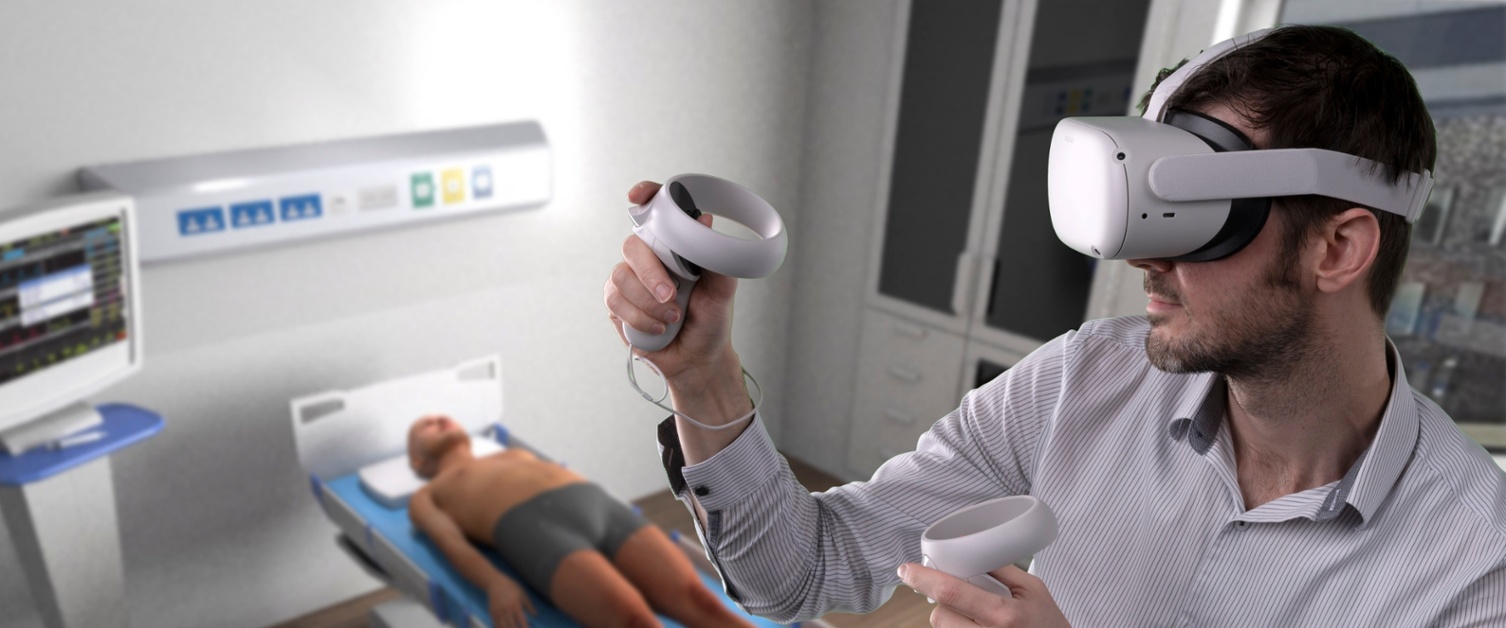Medical illustration team turn teaching idea into reality

Swansea Bay’s Medical Illustration Department is using virtual reality to teach new doctors a real life or death technique.
The department has teamed up with Swansea University to produce a virtual reality (VR) training app that helps perfect a potentially lifesaving technique, known as the Valsalva manoeuvre, to correct an abnormal cardiac rhythm, called Supraventricular Tachycardia (SVT), on a virtual patient.
The app includes the medical procedure for practice, an introduction to VR for those new to the technology and an online dashboard with performance analytics.
It was designed for standalone headset use, allowing for a seamless training experience with no cables. When using the app, the trainee is guided through each step of the manoeuvre, there is also a questionnaire pre and post procedure to assess their knowledge.
The project was kindly funded by the Swansea Bay Health Charity.
Steve Atherton (pictured above), Deputy Head of SBUHB’s Medical Illustration, played a lead role in the app’s development.
He said: “It was the idea of Dr Kevin Mohee, who worked in Morriston’s cardiology department at the time. He wanted to develop something in VR and he came up with the idea of the Valsalva manoeuvre because it’s relatively simple to perform.
“It’s a fairly common condition which is quite easy to treat initially without drugs or fancy interventions, using simple techniques involving stimulating a nerve in the neck which can reset the heart rhythm.
“They could watch a video on YouTube but the real advantage of VR is they can practice the technique on a virtual patient and if they get it wrong, it’s not the end of the world.”
Steve turned to Swansea University for help and after contacting Dr Marc Holmes, a Virtual Reality MSc course lecturer, his Morriston Hospital based team were put in contact with two MA students, Joe Charman and Jack Bengeyfield, who had set up their own software studio, Pilot Plus.
He said: “I made the characters and the virtual world but Joe and Jack came in with their programming knowledge and supplied the code to make that world come to life.
“We wrote a plan of action, decided what you’d see when you put the headset on and what you want it to do, then those guys did the computer programing to make it happen. You are in the room and the patient is animated, they can sit up or lie down and the bed moves.
“I basically gave them a 3D room, they had the task of making it work.”
Of the collaboration he said: “I was thrilled to be able to share knowledge and collaborate on a project with Pilot Plus. It's a great example of how fruitful we can be when the health board works with the university and local tech companies.
“I thought developing something like this was the preserve of big companies in London or America but I wanted to know what a medical illustrator, like myself, could do within the NHS. I’ve got a skill set with 3D but I’m not a computer programmer, so I linked up with Swansea University to use two virtual reality masters students to help with the programming side.”
The next step is to conduct a proper trial of the app before making it available to all.
“We’re going to invite some medical students and some junior doctors to come in and test it. It has been trialled already by some doctors but we want to do a large cohort of 40 to have a good go at it before filling a feedback form and questionnaire to get their opinion and to drive any changes.
“Hopefully it will be up and running by the end of the year. We don’t plan to make it a money making opportunity, it will be given away free.”
The team plans to develop other VR packages to help with medical training in the future.
Steve said: “The world is our oyster. There are loads of ideas but I’ll be guided by the clinicians, they are the ones doing the teaching. There’s no shortage of ideas, the only limit is the funding aspect.
“Talking of which, it was funded by the Health Board Charity and I would like to thank them very much, it couldn’t have happened without them.”
Joe Charman said: “It was great to work with Swansea Bay Health Board to turn their vision into a Virtual Reality application.
“Both the medical illustration from Steve and clinical expertise from Kevin were instrumental in guiding the creative process.
“We look forward to creating more Virtual Reality applications to aid both patients and clinicians.”
Rydym yn croesawu gohebiaeth a galwadau ffôn yn y Gymraeg neu'r Saesneg. Atebir gohebiaeth Gymraeg yn y Gymraeg, ac ni fydd hyn yn arwain at oedi. Mae’r dudalen hon ar gael yn Gymraeg drwy bwyso’r botwm ar y dde ar frig y dudalen.
We welcome correspondence and telephone calls in Welsh or English. Welsh language correspondence will be replied to in Welsh, and this will not lead to a delay. This page is available in Welsh by clicking ‘Cymraeg’ at the top right of this page.